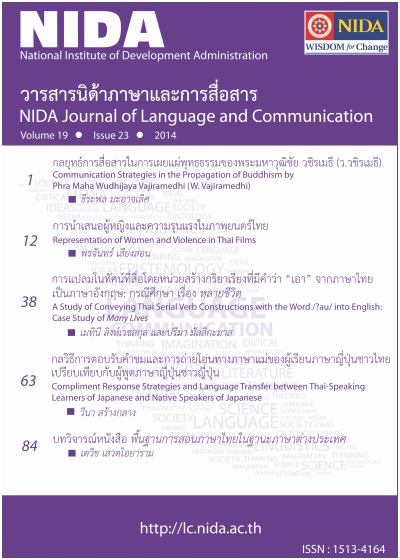Communication Strategies in the Propagation of Buddhism by Phra Maha Wudhijaya Vajiramedhi (W. Vajiramedhi)
Keywords:
W. Vajiramedhi, the propagation of Buddhism, content analysisAbstract
The objectives of this research are: 1) to study the presentation styles of literary works in the propagation of Buddhism by W. Vajiramedhi, and 2) to study the ideas and persuasive language used in the propagation of Buddhism by W. Vajiramedhi, both of which were conducted by means of Content Analysis. Thereby, the researcher studied 13 volumes of Applied Dharma for New Generation based on qualitative and quantitative analysis in order to find out the conclusion, to descriptively discuss the results, and to present the relevant statistics.
The results of this research answer the following 3 research questions. First, as to the question about how to name the individual subjects in Applied Dharma for New Generation by W. Vajiramedhi, the results showed that the author used phrases as subjects most frequently, 61.25%, followed by clauses 36.25%, and rhymes between words, 25.63%, respectively. In addition, it was found that the author always used 2-4 methods altogether to name the subjects. The most frequently used method is two-type relation (two types), in which rhymes between words and phrases were used together most often (12.5%), followed by three-type relation, in which the author used the rhymes between words, clauses, and figure of speech together most frequently (1.88%). Referring to the question about tactics and tricks employed in the Lord Buddha's preaches, which were found in Applied Dharma for New Generation by W. Vajiramedhi, it was found that the author used illustrated tales most often, 79.37%, followed by (6) analogy, 53.12%, and tricks for individual selection and practice, 29.37%, respectively. Besides, the results reflected that the author always employed 2-4 tactics used in the Lord Buddha's preaches altogether. The most frequently used method is two-type relation (two types), in which illustrated tales and analogy were used most often (39.38%). This is followed by three-type relation, in which the author employed illustrated tales, analogy and language tricks, and word tricks and neology most frequently (8.75%). According to the final question in terms of persuasive communication process in Applied Dharma for New Generation by W. Vajiramedhi, it was found that the author relied on the persuasive writing technique “persuasive suggestions to avoid objections” most often, 86.25%, followed by “use of personal identities or renown for persuasion”, 76.87%, and “giving reasons on the basis of facts”, 58.12%. It was also found that the author usually used at least 2 techniques of persuasive writing together including: 1) two-type relation, in which the most frequently used techniques were “use of personal identities or renown for persuasion” and “persuasive suggestions to avoid objections”, 63.75%; 2) three-type relation, in which the most frequently used techniques were “persuasive suggestions to avoid objections”, “giving reasons on the basis of facts”, and “use of personal identities or renown for persuasion”, 35.63%; and 3) four-type relation, in which all of the aforementioned techniques were used together, 10.63%.
The results of this research have brought about some suggestions for those who write religious literary works in order that they could employ presentation styles and persuade readers more successfully and more efficiently. Moreover, there have been some suggestions for further researches; for instance, the contexts of both authors and readers should be studied together in terms of attitudes towards the religious literary works, or there should be a study of comparative contexts between Dharma preaching on audio recording media and television media presenting religious programs.
Downloads
How to Cite
Issue
Section
License
By submitting a manuscript, the author transfers the copyright for the article to School of Language and Communication, National Institute of Development Administration (NIDA), if and when the manuscript is accepted for publication. Though the journal is an open-access, reproduction of any material published in NIDA Journal of Language and Communication for non-personal and/or commercial purpose requires a written permission from School of Language and Communication, National Institute of Development Administration (NIDA).






